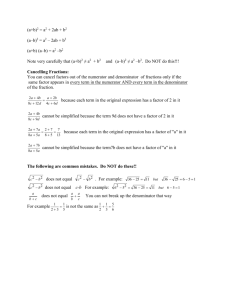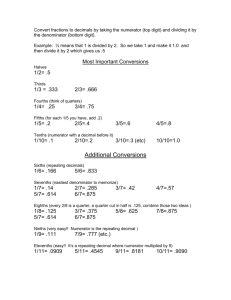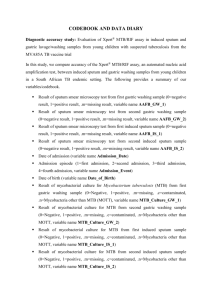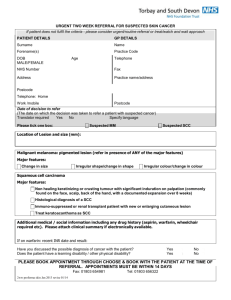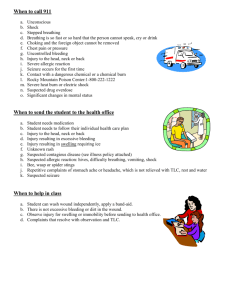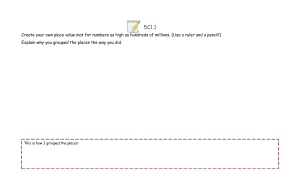at the end - World Health Organization
advertisement
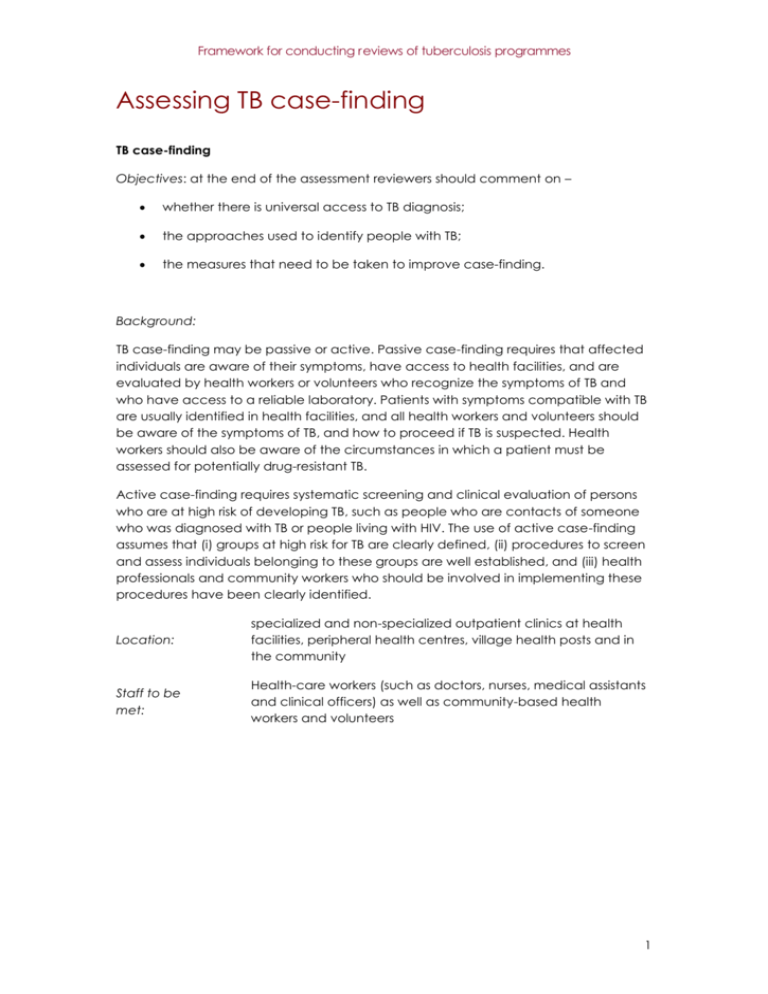
Framework for conducting reviews of tuberculosis programmes Assessing TB case-finding TB case-finding Objectives: at the end of the assessment reviewers should comment on – whether there is universal access to TB diagnosis; the approaches used to identify people with TB; the measures that need to be taken to improve case-finding. Background: TB case-finding may be passive or active. Passive case-finding requires that affected individuals are aware of their symptoms, have access to health facilities, and are evaluated by health workers or volunteers who recognize the symptoms of TB and who have access to a reliable laboratory. Patients with symptoms compatible with TB are usually identified in health facilities, and all health workers and volunteers should be aware of the symptoms of TB, and how to proceed if TB is suspected. Health workers should also be aware of the circumstances in which a patient must be assessed for potentially drug-resistant TB. Active case-finding requires systematic screening and clinical evaluation of persons who are at high risk of developing TB, such as people who are contacts of someone who was diagnosed with TB or people living with HIV. The use of active case-finding assumes that (i) groups at high risk for TB are clearly defined, (ii) procedures to screen and assess individuals belonging to these groups are well established, and (iii) health professionals and community workers who should be involved in implementing these procedures have been clearly identified. Location: specialized and non-specialized outpatient clinics at health facilities, peripheral health centres, village health posts and in the community Staff to be met: Health-care workers (such as doctors, nurses, medical assistants and clinical officers) as well as community-based health workers and volunteers 1 Framework for conducting reviews of tuberculosis programmes Assessment 1. Identifying and managing people suspected to have TB a. How do health-care workers and others involved in TB case-finding, such as community workers or volunteers, identify suspected cases of TB? (Interview the health workers.) What are the clinical criteria for suspecting TB (for example, do they ask patients if their cough has lasted for longer than 2 weeks)? Do they evaluate patients who are HIV-positive? Do they ask about symptoms in children or whether a child is a contact of someone diagnosed with TB? In which situations does the risk of TB that is resistant to anti-TB medicines need to be evaluated? b. What algorithms or standard operating procedures are available? How are patients suspected of having TB managed in the local setting (that is, are there arrangements for referring patients for testing with microscopy, chest radiography or the Xpert MTB/RIF test (Cepheid, Sunnyvale, CA )? Do the healthcare workers use a combination of screening tools and assessment procedures? c. Assess the quality of these algorithms or standard operating procedures. d. Do the health-care workers follow the algorithms or standard operating procedures when assessing patients? e. If a log book is available, ascertain the proportion of patients seeking health care who: i. present with respiratory symptoms; ii. are classified as suspected of having TB; iii. are referred for sputum examination. f. Is a register used to record patients suspected of having TB? g. Identify how well services are coordinated between the outpatient clinic and the laboratory. i. Are the forms needed to request sputum examination available? Are they used? ii. What is the procedure for sputum collection? Where is sputum collected? (Observe whether sputum is collected in well ventilated areas or outside the building.) iii. Are the sputum-collection containers adequate? How are they labelled? iv. Who is responsible for instructing the patients how to produce sputum? Are instructions provided clearly and correctly? 2 Framework for conducting reviews of tuberculosis programmes v. What are the procedures for collecting, storing and transporting sputum samples to the laboratory? How often are specimens transported (daily or weekly)? How long does it take, on average, for specimens to reach the laboratory? h. If a register is used to collect information on patients suspected to have TB does it include the patient’s name and address, the results of HIV tests, the date of sputum collection, the date the sputum sample was sent to the laboratory, the date results were received from the laboratory, and the results of the sputum examination? How are the accuracy and completeness of the information recorded in the register assessed? i. Is there a system for following up patients suspected of having drug-resistant TB? Is there a register where patients referred for drug-susceptibility testing (DST) are recorded? j. Do staff know the key indicators (for example, the percentage of outpatients with persistent cough, the percentage examined by microscopy and the positivity rate)? Are there any reports on these indicators? How is the quality of reporting assessed? k. Have health-care workers and volunteers been trained to identify and manage people suspected of having TB, including those suspected of having drugresistant TB? (See the checklist for Assessing the programmatic management of drug-resistant TB.) If yes, when was the training provided and who provided it? l. Is chest radiography available and is it used? If it is not available, are people suspected of having TB referred elsewhere for chest radiography? If so, how does the referral procedure work, and how are the results communicated to the clinic? m. Are any civil society organizations active in detecting TB? If yes, how are they linked to the clinic or health facility? If a patient was referred by a civil society organization, a community-based worker or a volunteer, is that noted in the register of patients suspected of having TB? 3 Framework for conducting reviews of tuberculosis programmes Indicators for: Identifying and managing people suspected to have TB (also see the section on Assessing implementation of the practical approach to lung health) Indicator Calculation Source of information Proportion of patients suspected to have TB among all outpatients (or adult outpatients) Numerator: number of suspected cases of TB Register of outpatients, register of patients suspected to have TB Denominator: total number of outpatients Proportion of patients suspected to have TB Register of patients suspected to have TB, chest radiography register, TB microscopy laboratory register, and Xpert MTB/RIFa register screened by chest radiography (if chest radiography is the primary screening tool specified in the national policy) Numerator: number of patients suspected to have TB screened by chest X-ray assessed by sputumsmear microscopy Numerator: number of patients suspected to have TB assessed by sputum-smear microscopy Denominator: total number of cases of suspected TB Denominator: total number of suspected cases of TB assessed using the Xpert MTB/RIF test Numerator: number of patients suspected to have TB assessed using the Xpert MTB/RIF test Denominator: total number of suspected cases of TB 4 Framework for conducting reviews of tuberculosis programmes Proportion of suspected cases of TB that is sputumsmear positive among the total number of suspected cases assessed by sputumsmear microscopy Numerator: number of suspected cases of TB that is sputum-smear positive Proportion of patients testing positive by Xpert MTB/RIF among all patients tested by Xpert MTB/RIF Numerator: number of patients positive by Xpert MTB/RIF testing Number of patients with rifampicin-resistant TB as a proportion of all patients testing positive by Xpert MTB/RIF Numerator: number of patients with rifampicin resistance Proportion of retreatment cases referred for culture and DST Numerator: number of retreatment cases referred for culture and DST TB laboratory register, Denominator: total number of patients suspected to have TB assessed by sputumsmear microscopy TB laboratory register, Xpert MTB/RIF register Denominator: total number of patients tested by Xpert MTB/RIF TB laboratory register, Xpert MTB/RIF register Denominator: total number of patients positive by Xpert MTB/RIF MDR-TB referral register Denominator: total number of retreatment cases Proportion of new TB cases referred for culture and DST Numerator: number of new TB cases referred for culture and DST MDR-TB referral register Denominator: total number of new TB cases TB, tuberculosis; DST, drug-susceptibility testing; MDR-TB, multidrug-resistant tuberculosis. a Xpert MTB/RIF test manufactured by Cepheid, Sunnyvale, CA. 5 Framework for conducting reviews of tuberculosis programmes 2. TB contact investigation Background: People who have been exposed to patients with infectious TB are called TB contacts; they constitute a high risk group for TB. Contact investigation contributes to the early detection of TB cases, and results in identifying a significant number of additional patients. The quality of TB contact-investigation activities and the appropriateness of their implementation should be assessed during the review. This assessment should be undertaken in the central unit of the national TB programme, the coordination units at the intermediate health level, the basic management units, first-level health facilities and, in some countries, at the community level. Assessment a. Is TB contact investigation included in the national policy to prevent and control TB? b. Are there clear national guidelines on investigating TB contacts? If yes, are they available in the health facilities visited (such as, the basic management units and firstlevel facilities)? c. Is TB contact investigation included in the national strategic plan for TB prevention, care and control? d. Is there a clear definition of an index case? If yes, who is considered to be an index case? e. Is there a clear definition of a contact? If yes, who is considered to be a TB contact? f. Are the procedures for screening and assessing TB contacts clearly defined? Are algorithms available for health-workers to use? g. Have staff who should carry out contact investigations been identified and are their roles well defined? h. Is there an information system that can be used to monitor and evaluate contactinvestigation activities? i. Which indicators are routinely used to monitor and evaluate these activities? j. Of all the TB cases registered during the past year, how many were identified through contact investigations? k. How many of the TB contacts who were identified and diagnosed with active TB were treated? k. Is chemoprophylaxis provided to TB contacts? If yes, to which categories of contacts is chemoprophylaxis provided? What type of chemoprophylaxis is provided to contacts? l. How many TB contacts received chemoprophylaxis during the past year? How many of them completed the chemoprophylaxis regimen? 6 Framework for conducting reviews of tuberculosis programmes Indicators for: TB contact investigation Indicator Ratio of the number of TBcontact investigations to the number of registered index cases Proportion of contacts screened for TB among contacts identified Prevalence of active TB among screened contacts Contribution of contact investigations to TB notification Calculation Numerator: number of TBcontact investigations carried out Denominator: number of registered index cases Numerator: number of contacts screened Source of information TB treatment register, information system for TB contact investigation, routine reports Information system for TB contact investigation and routine reports Denominator: number of contacts identified Numerator: number of active TB cases identified by investigating contacts Information system for TB contact investigation, routine reports Denominator: number of contacts screened during investigations Numerator: number of active TB cases identified by investigating contacts during a period of time TB treatment register, information system for contact investigations, routine reports Denominator: number of TB cases registered during the same period of time 7 Framework for conducting reviews of tuberculosis programmes 3. TB case-finding in high-risk groups (For information on intensified case-finding in people living with HIV see the section on Assessing TB/HIV collaborative activities.) Background: A risk group for TB is any group of people within which the prevalence or incidence of TB is significantly higher than in the general population. A risk group may be a group of people (i) sharing a specific individual-level risk profile, such as living with diabetes or being a smoker; (ii) living in a specific area where TB is highly prevalent, such as poor neighbourhoods or slums in big cities; (iii) working in a particular occupational setting where the risk of TB is high, such as in a mine where workers are exposed to silica dust; or (iv) incarcerated in a penitentiary institution. The increase in the risk of TB occurrence in comparison with the general population differs significantly across risk groups; for instance, the risk of TB may be 10 times higher, and even more, among prisoners than in the general population, while it is usually 2 to 3 times higher in patients with diabetes or in people who smoke tobacco. The profiles of risk groups should be clearly defined for each country. To identify and manage TB in these risk groups, clear strategies need to be defined and implemented. During the review, the appropriateness of the strategies used for case-finding among different risk groups (other than people living with HIV) and the implementation of those strategies should be evaluated in the central unit of the national TB programme, the coordination units at the intermediate health level, the basic management units, first-level health facilities and in the community. Assessment a. How are the groups at high risk for TB identified? Which criteria are used to determine whether a population is at high risk for TB? b. Is there a dataset at the central level that includes comprehensive information on all TB cases registered in the country? c. If yes, does the dataset include an adequate number of variables that allow risk groups to be identified? d. Are studies of the distribution of these variables carried out regularly and appropriately at the central level and intermediate level? Do the studies specify the number of TB cases in each risk group as a proportion of the total number of notified cases? e. Is there a list of clearly identified risk groups at the central level? Have any specific lists been compiled at the intermediate level? Is the number of people in each risk group known? f. Has the prevalence of TB been estimated for each risk group that has been identified? g. Are strategies for TB case-finding in people considered to be at high risk included in the national policy to prevent and control TB? Which risk groups have been prioritized, and what is the rationale for the prioritization? 8 Framework for conducting reviews of tuberculosis programmes h. Are procedures to identify and manage TB in each risk group well defined? Are there algorithms, standard operating procedures or guidelines for each risk group describing how case-finding and case-management should be undertaken? i. Is the role of health workers at each level of the health-care system clearly described in the standard operating procedures or guidelines? j. Have people who work with members of high-risk groups been identified to help with case-finding? Who are these people (for example, do they work in the health services of the penitentiary system, in occupational health services, or are they employers, staff of diabetes programmes, staff of NGOs operating in communities, staff of social services departments)? Are there links between active TB case-finding and diabetes programmes, smoking cessation programmes or activities associated with the practical approach to lung health(also known as PAL)? k. Is an information system used to monitor and evaluate activities related to TB case-finding and case-management in high-risk groups? l. Which indicators are used routinely to monitor and evaluate these activities? Are the indicators specific to each risk group? m. How many people in each risk group were screened last year? Of all the TB cases registered during the past year, how many were identified in these risk groups? What is the contribution of case-finding activities in each risk group to the total number of TB cases notified? n. Is chemoprophylaxis provided to members of any of these risk groups? If yes, to which risk groups was chemoprophylaxis provided and which type of chemoprophylaxis? o. How many people belonging to these risk groups received chemoprophylaxis during the past year? (The number should be specified for each risk group.) p. How many people offered chemoprophylaxis completed the treatment? Indicators for: TB case-finding in high-risk groups (other than people living with HIV) Indicator Prevalence of active TB among members of risk groups for TB (by risk group) Contribution of TB casefinding activities in each risk group to TB notification Calculation Numerator: number of active TB cases identified in each risk group Denominator: number of people screened for active TB in the same risk group Numerator: number of active TB cases identified in each risk group during a period of time Source of information TB treatment register, information system for TB in risk groups, routine reports TB treatment register, information system for TB in risk groups, routine reports Denominator: number of active TB cases registered during the same period of time 9
